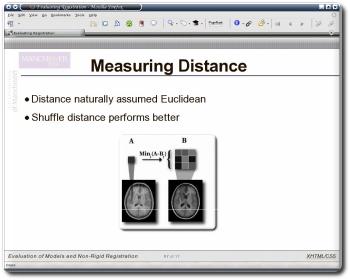
An example multi-file, Web-based presentation (click to start)
 ENCENTLY, I have being passively swayed (“forced” rather) towards using WYSIWYG applications for composition of a presentation. I have done that as a teenager, but I sure know the issues associated with the paradigm. I use OpenOffice at the moment, in conjuction with colleagues who stubbornly stick to PowerPoint.
ENCENTLY, I have being passively swayed (“forced” rather) towards using WYSIWYG applications for composition of a presentation. I have done that as a teenager, but I sure know the issues associated with the paradigm. I use OpenOffice at the moment, in conjuction with colleagues who stubbornly stick to PowerPoint.
As sad as this may sound, it seems obvious that, judging by the large, conferences do not accept presentations in formats such as HTML, even if they are as advanced and rich as S5 (exemplified above). Many conference them make PowerPoint the sole option, thus snubbing anybody who does not use Windows or is unwilling to invest in expensive licences that lead to vendor lock-in. Fortunately, I work in O/S-tolerant environments, so I rarely need to suffer from such narrow-mindedness.
WYSIWYG is a good paradigm in principle. Alas, as explained several times in the past (e.g. Dangers of Abstraction), WYSIWYG tends to be lossy. Also, re-use becomes as serious problem; searching and indexing likewise. The idea of encapsulating objects like arrows and circles in a single file, along with videos, images and text is ‘unhealthy’ to say the least. A binary presentation is not one which is open for standards-based tools to interpret. It is also poorly-structured.
OpenDocument does not make it trivial for one to extract individual objects unless various tools are used. Therefore, I am reluctant to ever use OpenOffice and yet I recommend and promote it. Hypocrisy? I say “nay”. Its entry barrier is low, and if not the cost, then open formats should make the difference and end the vendor/product dependency. OpenOffice will never suffer from the same pitfalls Microsoft vainly ignore.
An HTML presentation has its text stored separately (under e.g. index.html). Additionally, there are videos and graphics as individual files in their own isolated directory. The technology which drives S5, as in this particular case, involves a collection of stylesheets which are easily exchangeable, interchangeable, and are stored aside, together with their associated graphics. Lastly, there is JavaScript to integrates this technology and make keyboard navigation, buttons and the like a practical reality.
To finish off with a rant, why is it that ‘simplicity’ ended up attaining a huge tar-like file which is obscure in terms of its content? If it were not for Microsoft Office, would somebody else have done the same? Some time ago I heard that Office files were bound to become a compressed files which contain all the peripheral files, e.g. images and graphs, completely apart. XML is frequently echoed by the media in this context. Could this be related to Microsoft’s recent proposal to open up their formats?

 ATER today I will deliver an important presenation on my recent research work. This work has been done in collaboration with UCL for the past few months. This comes amidst 2 days of talks (the first day was yesterday), which slow down my activity on the Internet.
ATER today I will deliver an important presenation on my recent research work. This work has been done in collaboration with UCL for the past few months. This comes amidst 2 days of talks (the first day was yesterday), which slow down my activity on the Internet.





 Filed under:
Filed under: 

 AID stands for Redundant Array of Independent (or Inexpensive) Disks. As yet, I find RAID somewhat redundant, at least in my individual scenarios and for my personal purposes.
AID stands for Redundant Array of Independent (or Inexpensive) Disks. As yet, I find RAID somewhat redundant, at least in my individual scenarios and for my personal purposes. In this era we live in, there is a mounting
In this era we live in, there is a mounting 
 I happened to find
I happened to find 
 ACK in 2002, I chose to work on a
ACK in 2002, I chose to work on a